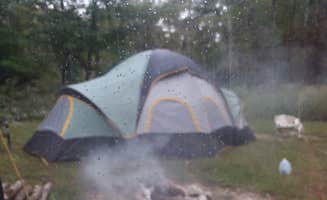Tent camping options near Bennett Springs, Missouri expand beyond the immediate state park into surrounding conservation areas and public lands. The region sits at approximately 850-900 feet elevation in the northern Ozarks, characterized by limestone bluffs, spring-fed streams, and oak-hickory forests. Summer temperatures typically range from 75-95°F with high humidity, while spring and fall offer more moderate conditions with occasional frost.
What to do
River fishing access: Fiery Fork Conservation Area provides direct access to the Niangua River for trout and smallmouth bass fishing. A camper noted, "The river access is really amazing though. It's a great place to launch a boat from or just to wade in a bit and fish. Fly fishing can be done easily from the bank or just by wading in a bit."
Wildlife observation: Multiple conservation areas maintain habitat for deer, turkey, and diverse bird species. Trails at DnD Campground Lakeside connect to wildlife viewing areas where campers report regular sightings of armadillos, deer and migratory birds, particularly during spring and fall seasons.
Hammock camping: Mature oak and hickory trees provide ideal hammock camping locations at many sites. One visitor to Fiery Fork noted, "The area was mowed, had a rock fire place, concrete picnic tables, a vault toilet, shade, grass for dogs to play frisbee, parking right beside your spot, trails, access to the river, good hammock trees, flat-level surface!"
What campers like
Affordability: Free camping at conservation areas makes these locations budget-friendly alternatives to developed campgrounds. A visitor commented, "Nice area to camp not crowded, plenty of space between camp sites, and peaceful. A nice place if your on a budget and just need a get away."
Natural setting: Wilbur Allen Memorial Conservation Area offers primitive camping with minimal development, creating a more immersive outdoor experience. The conservation area maintains vault toilets but otherwise preserves the natural landscape with minimal improvements.
Seasonal flexibility: Many conservation areas remain open year-round for camping, though visitor reports indicate April-October offers the most comfortable conditions. A camper at McCubbins Point noted the area has "Public boat ramp nice cooking spots" which remain accessible in multiple seasons.
What you should know
Cell service limitations: Prepare for extremely limited or non-existent connectivity. A camper at Fiery Fork reported: "We have AT&T for our cell service and there was absolutely NO service there which was good to get away, but bad in an emergency."
Access road conditions: Many conservation area camping sites require traveling gravel roads that may become impassable during wet conditions. A visitor noted: "If the waters too high, there's a bridge into the site that could be flooded so watch the weather."
Pack out requirements: Conservation areas typically lack trash facilities, requiring campers to take all waste with them. One camper advised: "There is no dumpster so be prepared to take your trash with you."
Seasonal crowds: Saline Valley Conservation Area experiences fluctuating visitor numbers with peak crowds on summer weekends. A Fiery Fork camper noted: "I stayed here for a few days in April. There were a few campers, but I'd be very surprised if this place isn't loud and packed in the summer."
Tips for camping with families
Riverside play areas: Several campgrounds offer shallow water access points for children. A visitor to Fiery Fork commented: "We decided it would be a nice place to bring our kids since there is quite a bit of 'beach' at the river access for them to play and see nature."
Site selection strategy: Choose campsites away from boat launch areas for quieter family camping, especially during summer weekends. Areas farther from water access points typically have less foot traffic and overnight noise.
Wildlife education opportunities: Bledsoe Ferry offers family-friendly wildlife viewing with one camper simply stating it was "Awesome" and "What a great place for the family."
Tips from RVers
Size restrictions: Most conservation area camping near Bennett Springs accommodates smaller trailers and RVs only. One camper advised: "I don't recommend taking it until it gets some maintenance. It is overgrown and HIGH tick contact probability. I recommend smaller RVs due to the 2 miles of gravel and high water areas you go through to get there."
Limited services: No electric, water, or sewer hookups exist at conservation areas, requiring complete self-sufficiency. Generator use may be restricted in primitive camping areas during certain hours.
Seasonal access challenges: Spring rains often affect road conditions, with several campers reporting access issues from March-May. Fall typically offers the most reliable access for RVs with moderate temperatures and drier road conditions.



